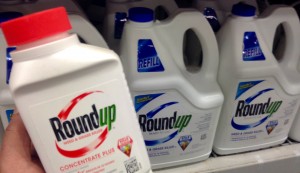10
Sep
California to List Glyphosate (Roundup) as Cancer-Causing
(Beyond Pesticides, September 10, 2015) Last week, California Environmental Protection Agency’s Office of Environmental Health Hazard Assessment (OEHHA) announced that it intended to list glyphosate (Roundup) and three other chemicals as cancer-causing chemicals under California’s Safe Drinking Water and Toxic Enforcement Act of 1986 (Proposition 65). Glyphosate is a phosphanoglycine herbicide that inhibits an enzyme essential to plant growth. Under California law, Proposition 65 requires that certain substances identified by the International View postAgency for Research on Cancer (IARC) be listed as known cancer-causing chemicals.
 In March, a study by the IARC classified glyphosate as a Group 2A material, which means that the chemical is carcinogenic based on sufficient evidence of carcinogenicity in experimental animals. The agency considered the findings from an EPA Scientific Advisory Panel report, along with several recent studies in making its conclusion. However, industry supporters of glyphosate all over the globe are conducting their own studies to attempt to prove that it is not a carcinogen. These studies, like one by German Federal Institute for Risk Assessments (BfR), are based almost solely on industry science and classified industry reports, each of which might not consider critical variables. With more glyphosate-focused studies being released, the growing evidence is becoming hard to ignore.
In March, a study by the IARC classified glyphosate as a Group 2A material, which means that the chemical is carcinogenic based on sufficient evidence of carcinogenicity in experimental animals. The agency considered the findings from an EPA Scientific Advisory Panel report, along with several recent studies in making its conclusion. However, industry supporters of glyphosate all over the globe are conducting their own studies to attempt to prove that it is not a carcinogen. These studies, like one by German Federal Institute for Risk Assessments (BfR), are based almost solely on industry science and classified industry reports, each of which might not consider critical variables. With more glyphosate-focused studies being released, the growing evidence is becoming hard to ignore.
While its creator Monsanto maintains that glyphosate is “safe for human health” and claims that the IARC’s conclusion was “reached by selective ”˜cherry picking’ of data and agenda-driven bias,” many recent studies prove otherwise.
Following the carcinogenic classification by the IARC, a research study published in the journal Environmental Health links long-term, ultra-low dose exposure to glyphosate in drinking water to adverse impacts on the health of liver and kidneys. The study focuses on Glyphosate-based Herbicides (GHBs), rather than pure glyphosate, unlike many of the studies that preceded it. Pediatrician Philip J. Landrigan, M.D., and researcher Charles Benbrook, Ph.D., recently released a prospective article on the effects of glyphosate and GE crops. In this article, they highlight the flaws of past glyphosate studies and conclude that they only considered pure glyphosate “despite studies showing that formulated glyphosate that contains surfactants and adjuvants is more toxic than the pure compound.” Their article also pointed to the ecological impacts of widespread glyphosate use, like the damage it has had on the monarch butterfly and other pollinators. Last year, the Center for Biological Study and Center for Food Safety filed a legal petition with the U.S. Fish and Wildlife Services seeking Endangered Species Act protection for the monarch butterfly. Their press release explains the dramatic 90 percent decline over the last 20 years:
The butterfly’s dramatic decline is being driven by the widespread planting of genetically engineered crops in the Midwest, where most monarchs are born. The vast majority of genetically engineered crops are made to be resistant to Monsanto’s Roundup herbicide, a uniquely potent killer of milkweed, the monarch caterpillar’s only food. The dramatic surge in Roundup use with Roundup Ready crops has virtually wiped out milkweed plants in midwestern corn and soybean fields.
Ecological effects like these are just a fraction of the environmental variables that should be considered when looking at the effects of glyphosate.
Joining glyphosate on the Proposition 65 list is malathion, parathion, and tetrachlorvinphos. A California Environmental Health Tracking Program (CEHTP) report, titled Agricultural Pesticide Use near Public Schools in California, finds that 36 percent of public schools in the state have pesticides of public health concern applied within a quarter mile of the school, including malathion and parathion. Malathion, which is also classified as a Group 2A material by the IARC, is a nonsystemic, widespectrum organophosphate nerve poison that causes numbness, tremors, nausea, incoordination, blurred vision, difficulty breathing or respiratory depression, and slow heartbeat, among others. Parathion and tetrachlorvinphos are also organophosphates that attack the nerve system, particularly in young children, causing neurological damage.
The mounting evidence of glyphosate’s hazards is piling up and environmental groups, like Beyond Pesticides, are urging localities to restrict or ban the use of the chemical. California’s glyphosate listing is certainly a step in the right direction; however, it will need to take further steps toward a restriction or ban to make significant changes. Being the number one agricultural producing state, California’s action may help to move glyphosate out of the market.
Currently, the best way to avoid glyphosate and other harmful pesticides is to support organic agriculture and eat organic food. Beyond Pesticides has long advocated for organic management practices as a means to foster biodiversity, and research shows that organic farmers do a better job of protecting biodiversity than their chemically-intensive counterparts. Instead of prophylactic use of pesticides and biotechnology, responsible organic farms focus on fostering habitat for pest predators and other beneficial insects, and only resort to judicious use of least-toxic pesticides when other cultural, structural, mechanical, and biological controls have been attempted and proven ineffective.
All unattributed positions and opinions in this piece are those of Beyond Pesticides










